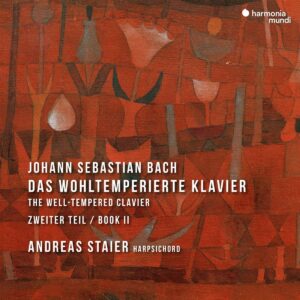If Wanda Landowska was sometimes accused of playing the harpsichord like a piano, one could say that Andreas Staier treats the harpsichord like an orchestra. And who can blame him, given the sonorous possibilities of his instrument based on a 1734 Hass model.
Staier’s Well-Tempered Clavier Book II Preludes and Fugues go for color, emotion, and forward sweep. He’s not afraid of full registrations, or of pressing ahead in fugal strettos for dramatic impact. Expressive gestures cohere due to Staier’s forceful inner rhythm, and totally avoid the fussy agogic pointing we hear from way too many harpsichordists in the name of “authenticity”. Indeed, encountering Staier’s Book II right after reviewing the reissue of Helmut Walcha’s dry-as-dust 1970s version is like going from a bread and water diet to gorging at a Jewish delicatessen.
The C major Prelude’s massive sonorities and driving vitality are closer to Bach/Busoni than Bach/Leonhardt. By contrast, the C-sharp major Prelude makes luscious use of the harpsichord’s lute stops, while Staier’s pliable and caressing D major Fugue benefits from gentler, less stentorian phrasing of the repeated note subject than we usually hear. Even with its thick doublings, the E-flat major Fugue still conveys an enchanting upbeat swagger, as does the F major Fugue, while the preceding F major Prelude takes its sweet, spacious, curvaceous time.
Staier shapes the G minor Prelude’s dotted rhythms flexibly in order to let the lowest notes sing out. One also might notice his treatment of the G-sharp minor Prelude’s repeated note phrase as a quick appoggiatura, followed by an offhandedly brisk Fugue. Perhaps the A minor Prelude best reveals the instrument’s kaleidoscopic scope, especially with Staier’s octave transpositions on the repeats. However, I would have preferred a less heavy and square reading of the dazzlingly chromatic B-flat minor Fugue.
There’s no question that certain harpsichord fans will prefer a lighter instrument, not to mention a less interventionist interpreter like Kenneth Gilbert or Masaaki Suzuki. Yet if you want fearless, creative Bach playing that both entertains and illuminates, Staier’s Book II is just the ticket. Needless to say, I look forward to his forthcoming Book I.
































